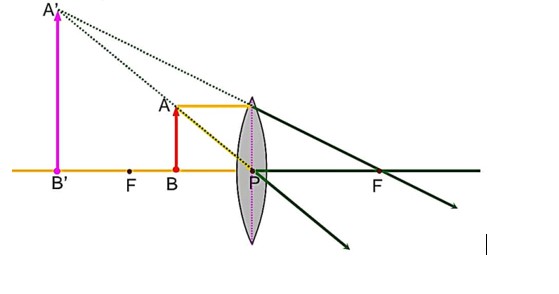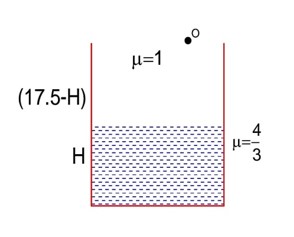Ray Optics and Optical Instruments
Get insights from 117 questions on Ray Optics and Optical Instruments, answered by students, alumni, and experts. You may also ask and answer any question you like about Ray Optics and Optical Instruments
Follow Ask QuestionQuestions
Discussions
Active Users
Followers
New answer posted
3 months agoContributor-Level 10
A total refractive prism is also known as a total internal reflection prism. It is an optical prism that is designed for reflecting 100% of the incident light. This happens since this prism uses the principle of total internal reflection. These prisms are oriented and shaped in a specific way so that the light that enters at a specific angle is completely reflected inside the prism. A right-angle prism, porro prism, dove prism and roof prism are some of the examples of total reflective prism.
New answer posted
3 months agoContributor-Level 10
Total deviation in a prism is the total angle by which the light ray gets bent as it passes through the prism. It is an angle between incident ray and emergent ray of the prism. When a light enters the prism, it will bend towards the normal. After that, it will travel through the prism and bend away from the normal as it exits. Total deviation is the sum of these two from which the apex angle is subtracted.
The formula for total deviation for a prism is as follows:
- : angle of incidence at first surface
- : angle of emergence at second surface
- A: apex angle of the prism
New answer posted
3 months agoContributor-Level 10
There are different types of glasses that are used in optical instruments, including the following:
Crown glass (K): This glass is used in eyeglasses, microscopes and cameras. It is used in prisms and windows in optical systems. Crown glass has a low refractive index, low dispersion and excellent transparency in visible spectrum.
Flint Glass (F): This glass, when combined with crown glass, can correct chromatic aberration in lenses. They are also used in prisms for spectroscopy.
Extra-low dispersion glass: These glasses are used in premium optics that are also used for making high-quality camera lenses, telescopes and binoculars.
New answer posted
3 months agoContributor-Level 10
Optical instruments can have some of the following defects that may impact their performance, which have arisen due to design limitations, manufacturing and physical properties of light:
- Chromatic Aberration: This defect occurs because of the different wavelengths of light that refract at slightly different angles when they pass through the lens. It causes them to focus on different points.
- Spherical Aberration: This happens because light rays pass through the edges of spherical lens or reflect off spherical mirror focus at different point than rays that pass through the center.
- Astigmatism: This type of defect occurs due to the uneven cu
New answer posted
3 months agoContributor-Level 10
Yes, optical instruments are used in modern medicine for many purposes including surgery, monitoring, research and diagnosis. Let us take a look at each one by one:
- Many optical instruments are used for visualizing internal structures for diagnosis of a disease and its monitoring. These include Ophthalmoscope, Endoscope, Colposcope and Dermatoscope.
- Optical instruments are also used for precision and minimally invasive surgeries, including Laparoscope, Arthroscope and Surgical Microscopes.
- Lasers are used for cutting, therapy and coagulation since they have precision and minimal invasiveness. CO? Laser, Excimer Laser and Fiber Optic
New answer posted
4 months agoContributor-Level 10
A camera lens focuses the light onto a light-sensitive surface like film or a digital sensor for capturing an image. The camera lens gathers as much light as possible for forming a clear and bright image. This lens focuses the collected light on a specific point like camera's film or its digital sensor. The focus is achieved due to the curvature of lens and the arrangement of its optical elements. This lens refracts light rays so that they converge at focal plane where film/sensor is located.
New answer posted
4 months agoContributor-Level 10
A telescope functions on the working principle of gathering light form distant source and then, forming image which can be magnified for observation. Based on their design, there are two types of telescopes including refracting telescopes and reflecting telescopes. A refracting telescope has a front lens called as objective lens. This front lens is a convex lens that collects light from distant objects and then bend it to the focal point. In a reflecting telescope, a concave mirror is the primary mirror that collects light and then, reflects it to a focal point.
New answer posted
4 months agoContributor-Level 10
The following happens when light refracts from a prism:
- When a white light passes through prism, it is separated into its constituent colours. This separation occurs because different colours of light are refracted in different amounts. This is known as dispersion.
- Prism's refractive index varies with the wavelength of light. This causes shorter wavelengths to bend more than longer wavelengths. Due to the variation in bending, spread of colours is visible in rainbow.
- After being dispersed within the prism, light rays reach second surface of the prism. Here, light rays again undergo refraction as they exit the prism and re-enter air.
New answer posted
4 months agoContributor-Level 10
For microscopic lens

Now in second case, this lens acts as objective of compound microscope, so according to question
New answer posted
4 months agoContributor-Level 10
As observer is at O So height of water observed by observer
given diagram (17.5 - H) is height of observer
7H = 70
H = 10

Taking an Exam? Selecting a College?
Get authentic answers from experts, students and alumni that you won't find anywhere else
Sign Up on ShikshaOn Shiksha, get access to
- 66k Colleges
- 1.2k Exams
- 680k Reviews
- 1800k Answers
